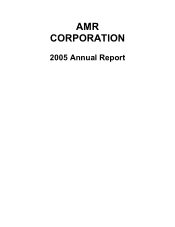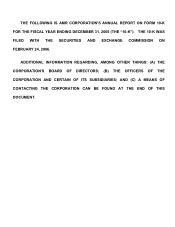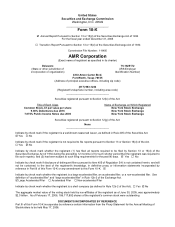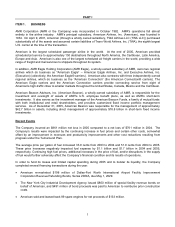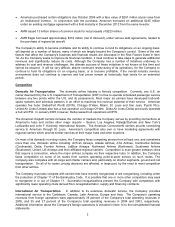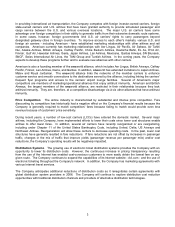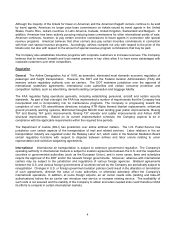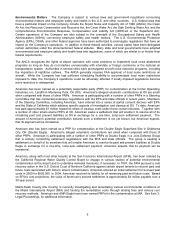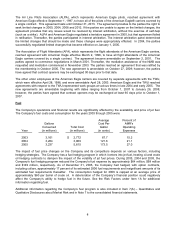American Airlines 2005 Annual Report Download - page 11
Download and view the complete annual report
Please find page 11 of the 2005 American Airlines annual report below. You can navigate through the pages in the report by either clicking on the pages listed below, or by using the keyword search tool below to find specific information within the annual report.
8
The Air Line Pilots Association (ALPA), which represents American Eagle pilots, reached agreement with
American Eagle effective September 1, 1997, to have all of the pilots of the American Eagle® carriers covered by
a single contract. This agreement lasts until October 31, 2013. The agreement provides to the parties the right to
seek limited changes in 2000, 2004, 2008 and 2012. If the parties are unable to agree on the limited changes, the
agreement provides that any issues would be resolved by interest arbitration, without the exercise of self-help
(such as a strike). ALPA and American Eagle negotiated a tentative agreement in 2000, but that agreement failed
in ratification. Thereafter, the parties participated in interest arbitration. The interest arbitration panel determined
the limited changes that should be made and these changes were appropriately effected. In 2004, the parties
successfully negotiated limited changes that became effective on January 1, 2005.
The Association of Flight Attendants (AFA), which represents the flight attendants of the American Eagle carriers,
reached agreement with American Eagle effective March 2, 1998, to have all flight attendants of the American
Eagle carriers covered by a single contract. The agreement became amendable on September 2, 2001. The
parties agreed to commence negotiations in March 2001. Thereafter, the mediation assistance of the NMB was
requested and mediation commenced in November 2003. The parties reached an agreement that was ratified by
the membership in October 2005. The new agreement is amendable on October 27, 2009; however, the parties
have agreed that contract openers may be exchanged 90 days prior to that date.
The other union employees at the American Eagle carriers are covered by separate agreements with the TWU,
which were effective April 28, 1998, and were amendable April 28, 2003. American Eagle and the TWU reached
agreements with respect to the TWU-represented work groups at various times in late 2004 and early 2005. The
new agreements are amendable beginning with dates ranging from October 1, 2007 to January 26, 2008;
however, the parties have agreed that contract openers may be exchanged at least 60 days prior to October 1,
2007.
Fuel
The Company’s operations and financial results are significantly affected by the availability and price of jet fuel.
The Company's fuel costs and consumption for the years 2003 through 2005 were:
Year
Gallons
Consumed
(in millions)
Total Cost
(in millions)
Average
Cost Per
Gallon
(in cents)
Percent of
AMR's
Operating
Expenses
2003 3,161 $ 2,772 87.7 15.2
2004 3,264 3,969 121.6 21.1
2005 3,237 5,615 173.5 27.0
The impact of fuel price changes on the Company and its competitors depends on various factors, including
hedging strategies. The Company has a fuel hedging program in which it enters into jet fuel, heating oil and crude
oil hedging contracts to dampen the impact of the volatility of jet fuel prices. During 2005, 2004 and 2003, the
Company’s fuel hedging program reduced the Company’s fuel expense by approximately $64 million, $99 million
and $149 million, respectively. As of December 31, 2005, the Company had hedged, with option contracts,
including collars, approximately 17 percent of its estimated 2006 fuel requirements and insignificant amounts of its
estimated fuel requirements thereafter. The consumption hedged for 2006 is capped at an average price of
approximately $60 per barrel of crude oil. A deterioration of the Company’s financial position could negatively
affect the Company’s ability to hedge fuel in the future. See the Risk Factors under Item 1A for additional
information regarding fuel.
Additional information regarding the Company’s fuel program is also included in Item 7(A) – Quantitative and
Qualitative Disclosures about Market Risk and in Note 7 to the consolidated financial statements.

